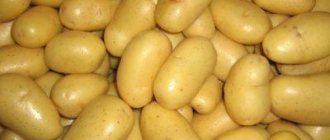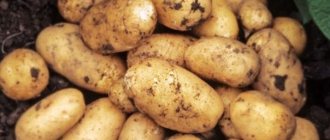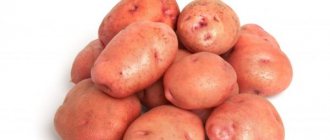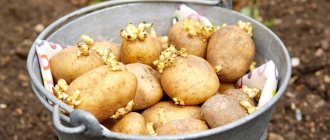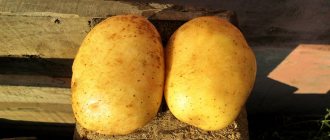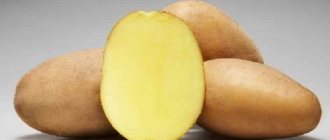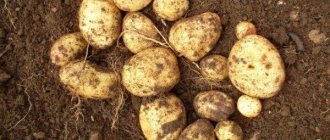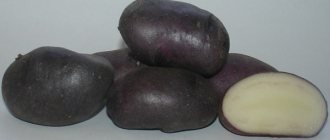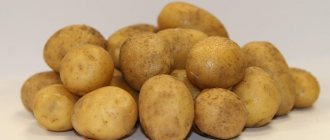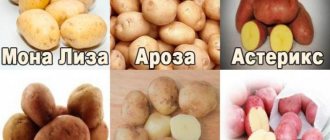Description of the variety
The Skazka potato belongs to the early varieties, because the crop is harvested already on the 85th day from the date of planting. The plant is medium-sized, reaches a height of up to 70 cm, and at the same time, has erect, not spreading stems, which is why it is convenient to hill up potato bushes. Inflorescences of 3-4 pale purple flowers are formed on the stems.
Important! According to the State Register, the variety is intended for planting in the Far Eastern, Ural and Middle Volga regions. However, many years of experience have shown that “Skazka” is successfully planted by farms in other regions.
Potatoes of the Skazka variety produce smooth, oval tubers with small eyes. The color of the tubers is light yellow, the cut flesh is white and slowly darkens after peeling. The size and weight of the tubers are small, the average weight is from 80 to 150 g. However, the tubers are resistant to mechanical damage and are easily transported and stored. The pulp of the tubers has universal value in cooking: it is equally suitable for frying, boiling, baking, stewing, as a side dish and as a main dish.
On average, one bush can produce up to 30 medium-sized tubers, thanks to which the variety has rightfully entered the category of super-yielding ones. According to the stated characteristics, 30-40 centners of marketable potatoes come out of one hundred square meters. This result can only be achieved by following agricultural practices, including regular fertilizing.
Advantages and disadvantages compared to other cultures
Fairy Tale potatoes have many advantages, but there are also negative aspects.
| Plus | Minuses |
| Abundant Harvest | Slightly deep eyes, which makes peeling the fruit difficult |
| Easy to care for | A tall, spreading bush of tops makes it difficult to care for |
| Durable protective functions | |
| Long shelf life | |
| Great taste | |
| Attractive presentation |
See also
Description and characteristics of the Red Scarlet potato variety, planting and care
Read
Advantages and disadvantages
Of course, Skazka potatoes have a number of key advantages that make up its advantages, namely:
- early ripening, subject to certain conditions, will allow you to harvest two harvests per year;
- gives high yields;
- medium-sized tubers are well stored and can be transported;
- has excellent taste;
- universal in cooking;
- ease of care;
- disease resistant.
Based on the listed characteristics, it is impossible to find any shortcomings. Some gardeners consider it too small, but one can argue with this, because for 1 kg of potatoes there are 10 tubers, which, due to their size, are easier to store. In addition, this size allows you to get about 3 kg from one bush.
Collection, storage and use of crops
Harvest in September. A week before harvesting, the tops are mowed to get rid of diseases and allow the root crops to ripen.
The dug up tubers are air dried for 6-10 hours. Then the dried potatoes are sorted, damaged and infected root crops are selected. The harvest is harvested for storage in cellars and basements, where the temperature is maintained at no more than +2°C. Humidity should be 90%. The room is sometimes ventilated, and spoiled tubers are sorted and removed once a month.
This variety is considered universal. It is boiled in its skin and used in salads, purees, and first courses. They also make casseroles.
Features of cultivation
Agricultural technology is quite simple, but you need to know it. Early potatoes require advance preparation of the site and seed material.
When choosing a site, it should be taken into account that the “Fairy Tale” potato does not like excess moisture, prefers loamy or sandy soil, exhausted peat bogs. The area should be well lit and ventilated. According to the rules of crop rotation, potatoes can be preceded by the cultivation of grains, legumes, root crops, cabbage or cucumbers. Unlike these crops, it is not advisable to plant potatoes after tomatoes, peppers, eggplants, and zucchini.
If the predecessor, according to the rules of crop rotation, is not suitable for potatoes, you should sow peas in August, which will bring triple benefits. Thus, microorganisms live on its roots, naturally enriching the soil with nitrogen. The very fact of planting peas will mean that potatoes will have a suitable predecessor crop. In October, the peas will grow so large that when plowed they will become green manure.
A good effect can be achieved if humus is added to the soil in the fall. Humus is often confused with manure, but it is important not to equate these concepts so as not to harm the future harvest. Manure is an unrotted animal product, the components of which have not yet been processed, may contain weed seeds and emit dangerous gases that inhibit plant growth.
At the same time, humus is already rotted manure, the components of which have turned into a homogeneous nutrient mass. It does not contain weeds and no longer releases substances that could damage the future harvest. Humus is applied to the soil, spreading it in a layer of 3-4 cm over the area. After this, the area is plowed.
Important! Thanks to plowing, most of the pests, fungi and bacteria that cannot withstand freezing temperatures die during the winter.
In the spring, the area is loosened, leveling the blocks of soil formed after plowing. This procedure is carried out manually with a rake, but mechanized processing with a milling cutter is preferable, which will turn the soil into a loose substance.
It is equally important to prepare the seed material for planting. The preparation of tubers begins about 30 days before planting. It is advisable to select those tubers whose sprouts have not broken off over the winter. They should be placed in a warm and well-lit room. Under the influence of light and temperature, which should be +15ºС +20ºС, the tubers begin to germinate.
There are many ways to compactly arrange tubers. If space allows, potatoes are spread on a floor lined with burlap in 1-2 layers. You can also use shallow boxes where the tubers are laid out. The boxes are placed one on top of the other so that they do not block the lighting for the potatoes. Another option is to string the tubers on soft fishing line and hang them from the ceiling. Thus, potatoes germinate in about 20 days.
You may be interested in: Dates for planting potatoes in 2021 for central Russia and the Moscow region Dates for planting potatoes in May-June 2021 according to the lunar planting calendar Favorable days for planting potatoes in 2021 according to the lunar calendar
A faster option is to germinate potatoes in plastic bags with a capacity of up to 5 kg, in which holes are made for ventilation. The greenhouse temperature that forms in the bag allows potatoes to germinate in 5-6 days.
After germination, sickly, limp potatoes or those that have formed thin sprouts are identified - they are unsuitable for planting.
Immediately before planting, potatoes are treated with the drug "Prestige", which has a fungicidal effect against scab and rhizoctonia, as well as an insecticidal effect against the Colorado potato beetle, wireworm, and aphids. 30 ml of the drug is dissolved in 0.6 liters of water. This solution should be enough for 30 kg of seed potatoes. Treatment method: spraying. Other fungicides can be used for prevention.
Immunocytophyte, Poteytin, and Zircon are used as potato growth stimulants. For example, to prepare a working solution of Poteytin, 5 ml of the drug must be dissolved in 20 liters of water - this is enough to process 1 ton of potatoes.
Plant “Fairy Tale” potatoes in soil that is at least 8-10 ºС. The planting pattern is 35x45 cm, the holes are made in a checkerboard pattern, adding a glass of ash, humus or 5 g of superphosphate to them. After burying the tubers, the area is leveled with a rake.
Caring for “Fairy Tale” potatoes
The main measures for caring for potato bushes include weeding, hilling, watering and fertilizing. Weeding of the beds is carried out as necessary 3-4 times during the entire growing season. For the first weeding, you can use electric trimmers. When the beds are hilled, they use hoes and various cultivators with “hedgehog” type attachments and disks.
It is advisable to hill up potatoes twice. The first time - a couple of weeks after germination, the second time - before flowering. To do this, the rows of potatoes are lightly sprinkled on both sides with ridges of earth, the height of which should not exceed 15-20 cm.
Potatoes are watered 5-7 times per season, saturating the soil up to half a meter. The intervals between waterings should be from 7 to 10 days, between which the soil is loosened. Often loosening is combined with hilling. In southern, drier regions, watering may be more frequent since the soil should not be allowed to dry out.
As fertilizing, 40 g of potassium nitrate and superphosphates are used per 10 liters of water, which are poured into the rows. The consumption rate of such a solution is one bucket per square meter.
Growing and care
The crop requires frequent hilling at the beginning of growth. The first hilling is carried out 2 weeks after germination, the second – after another 2-3 weeks. Early hilling helps increase yield by up to 30%, as it promotes the formation of new roots.
Bushes are watered during the following periods:
- When reaching a height of 10-12 cm.
- At the beginning of flowering.
- After flowering.
The variety does not require fertilizing if the soil has been previously enriched with mineral and organic fertilizers. During the flowering period, weak potassium-phosphorus fertilizers can be applied to increase productivity.
Diseases and pests
The Skazka variety is resistant to scab, potato blight, macrosporosis, and many fungal diseases, including late blight. As noted above, preventive treatment with the drug “Perstige” or its analogue is carried out even during planting. This treatment should be sufficient, given that the drug leaves the tubers after 60 days. However, if symptoms of one of the diseases appear, the desired drug is selected based on the symptoms.
The main potato pests are the Colorado potato beetle, aphids, potato golden nematode, and wireworm. As a preventative measure, potatoes are treated with insecticides Borey, Tanrek, Konfidor, Vofatoks and others.
In conclusion, it is necessary to note the versatility of the Skazka variety, which in all respects satisfies the needs of both small gardeners and large farmers. The characteristics of yield, shelf life, transportability and taste allowed the variety to conquer a large segment of the agricultural market.
Reviews
Alena, Voronezh
The Skazka variety really shows fabulous yields, despite little experience in farming. As a piece of advice, I would draw attention to the need for timely hilling, which can be carried out even more than 2 times, combined with loosening. As for fertilizing, it is better to alternate organic matter with mineral fertilizers. From organic matter, I choose any compost and dilute it in a ratio of 1:10. From mineral fertilizers, choose potassium sulfate or superphosphate (35-40 g per 1 liter of water).
Vladislav, Kemerovo
I consider proper storage of seed tubers to be another important nuance in growing the Skazka variety. Significant germination should not be allowed. I immediately select seed potatoes after harvesting and place them in separate boxes. I store it separately in the basement in the coolest and darkest place, additionally covering the boxes with burlap. This allows the tubers to maintain their strength until spring.
Landing
Potatoes are planted in the spring, when the soil warms up to +8 degrees or more.
In the fall, it is necessary to prepare the site and seed tubers. For planting immediately after harvesting, select high-quality root vegetables weighing 60-70 g. To ensure that they are well preserved, they are laid out in the sun for several hours to form solanine.
In the spring, the tubers are laid out in a thin layer in good light and at a temperature higher than in storage. At a temperature of +12-15, the shoots will reach 3 cm in about 3-4 weeks.
Before planting, potatoes are sprayed with a stimulant solution with the addition of a fungicide.
Potatoes prefer loose sandy loam soils or nutritious chernozems; they can grow on loamy soils, but if they have too much clay, they are heavy and dense, the harvest will be smaller. To make the soil light and loose, add river sand and dry peat.
Select a site after legumes or winter grains. Also good predecessors are cabbage, carrots, cucumbers, zucchini, radishes, radishes, onions, various greens, and corn.
The variety cannot be planted after other types of potatoes or nightshade crops. It is better to change the landing site annually, but if this is not possible, then as often as possible.
In autumn, the soil is dug deeper and organic fertilizers (humus or fresh manure, compost) are added. In the spring, dig up again, adding superphosphate and potassium sulfate. For normal, not depleted soil, half a bucket of organic fertilizer per 1 square meter is enough. m. It is necessary to remove the remains of the old tops. If plants were affected by fungi last year, the soil should be watered with a solution of potassium permanganate or a fungicide.
There should be 30-40 cm between holes, and 60-70 cm between rows.
